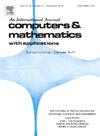通过亥姆霍兹分解求解弹性散射问题的稳健边界积分方程
IF 2.9
2区 数学
Q1 MATHEMATICS, APPLIED
引用次数: 0
摘要
弹性场的亥姆霍兹分解为通过边界积分方程(BIE)解决线性弹性散射问题开辟了新途径(Dong 等(2021)[20])。这种方法的主要吸引力在于随之而来的 BIE 系统只具有与亥姆霍兹方程相关的积分算子。然而,这些 BIE 涉及的非标准边界积分算子并不是在对 Helmholtz 单层和双层势应用 Dirichlet 或 Neumann 迹之后产生的。相反,亥姆霍兹分解方法导致了具有诺伊曼边界条件的弹性散射问题的 BIE 公式化,其中涉及亥姆霍兹层势赫西亚的边界迹。因此,在亥姆霍兹分解框架内应用经典的组合场方法会产生 BIE 公式,虽然稳健,但不属于第二类。按照 Boubendir 等人(2015)[6] 中介绍的正则化方法,我们设计并分析了用于解决弹性散射的新型稳健亥姆霍兹分解 BIE,这种 BIE 在二维光滑散射体情况下属于第二类。我们介绍了基于 Nyström 离散的各种数值结果,这些结果说明了第二类正则化公式与迭代求解器的良好性能。本文章由计算机程序翻译,如有差异,请以英文原文为准。
Robust boundary integral equations for the solution of elastic scattering problems via Helmholtz decompositions
Helmholtz decompositions of the elastic fields open up new avenues for the solution of linear elastic scattering problems via boundary integral equations (BIE) (Dong et al. (2021) [20]). The main appeal of this approach is that the ensuing systems of BIE feature only integral operators associated with the Helmholtz equation. However, these BIE involve non standard boundary integral operators that do not result after the application of either the Dirichlet or the Neumann trace to Helmholtz single and double layer potentials. Rather, the Helmholtz decomposition approach leads to BIE formulations of elastic scattering problems with Neumann boundary conditions that involve boundary traces of the Hessians of Helmholtz layer potential. As a consequence, the classical combined field approach applied in the framework of the Helmholtz decompositions leads to BIE formulations which, although robust, are not of the second kind. Following the regularizing methodology introduced in Boubendir et al. (2015) [6] we design and analyze novel robust Helmholtz decomposition BIE for the solution of elastic scattering that are of the second kind in the case of smooth scatterers in two dimensions. We present a variety of numerical results based on Nyström discretizations that illustrate the good performance of the second kind regularized formulations in connections to iterative solvers.
求助全文
通过发布文献求助,成功后即可免费获取论文全文。
去求助
来源期刊

Computers & Mathematics with Applications
工程技术-计算机:跨学科应用
CiteScore
5.10
自引率
10.30%
发文量
396
审稿时长
9.9 weeks
期刊介绍:
Computers & Mathematics with Applications provides a medium of exchange for those engaged in fields contributing to building successful simulations for science and engineering using Partial Differential Equations (PDEs).
 求助内容:
求助内容: 应助结果提醒方式:
应助结果提醒方式:


